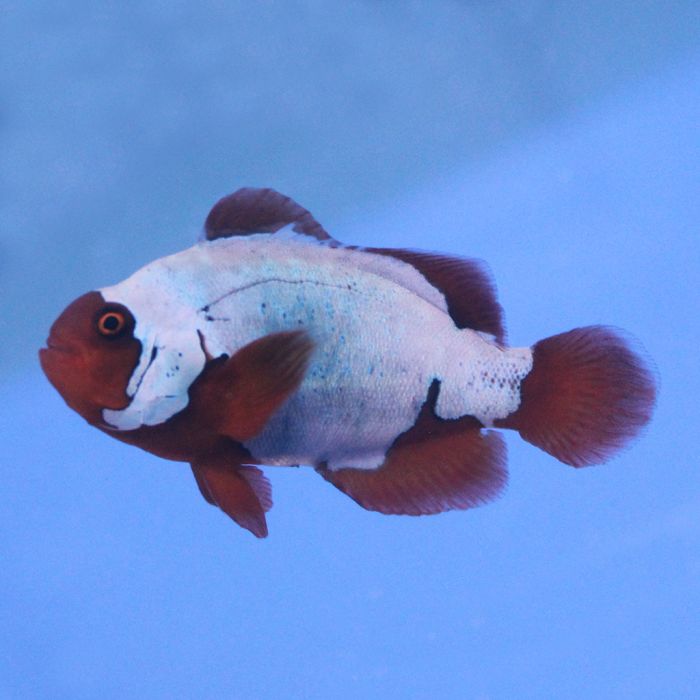Maroon (Thunder) Clownfish (Tank Raised)
Viewing this phenomenal fish will leave you feeling aftershocks... much like the reverberations after a strike of lightning! By breeding the best and whitest Lightning clownfish the Thunder variety was developed. Only its extremities retain the deep red color. Its hard to imagine a more stunning creature than this.
Female Maroon clownfish may grow up to 6.5 Inches, with males much smaller; sometimes the female may be up to six times the size of her mate. They are very aggressive and need an aquarium at least 50 gallons or larger.
Maroon clownfish are one of the most belligerent of all the clownfish, and will kill any other clownfish species in their aquarium. They are best kept singly, however if a pair is to be attempted wild pairs are often collected and available together. For tank bred fish, the female should be as big as possible and the male as small as possible and added into the female's tank. This is because all Maroon clownfish want to be the most dominant, and unless there is a clear inequality in size neither fish will back down until one of them is killed. It may be beneficial to have a second host for the male fish to retreat to when his mate is feeling feisty.
They may host with nearly any anemone species, except Atlantic species.
Best hosts are Bubble Tip (Entacmaea quadricolor), Long tentacle (Macrodactyla doreensis), Magnifica/Ritteri (Heteractis magnifica), and Sebae (Heteractis crispa).
Clownfish are hardy, easy to keep and are a perfect first fish for a new aquarium. Most species are available tank bred. They are omnivorous and easy to feed on high quality food items such as frozen Mysis shrimp, enriched brine shrimp, and dry foods, preferably more than once a day.
Clownfish are well known for their charming wiggling way of swimming, which serves them well in their natural home, within the stinging tentacles of an anemone. The exact reason clownfish are not stung is not known, but it may have something to do with the fish's slime coat. In the ocean, without the protection of the anemone, clownfish would be easily picked off by predators. In an aquarium the anemone, which has much more demanding needs than the fish, is not necessary. The fish may instead host with a soft coral such as furry mushrooms, toadstool leather, colt coral, or even within macro algae. It may choose to host within large polyp stony corals such as Euphyllia sp. as well, however the coral does sting the fish. We don't recommend encouraging them to host with delicate corals such as bubble or brain type corals, which the fish may injure with its constant swimming. Even with an anemone in the aquarium the fish will chose to host with whichever home it likes best.
Clownfish may be kept singly, or more commonly in pairs, in which case the smallest more submissive fish remains a male, and the largest most dominant fish changes sex to become a female. Clowns are related to damselfish, and pairs will not tolerate other species of clownfish within their territory (which may include 50 gallons of space or more) and may fight to the death. They are prone to parasitic infections such as Brooklynella and velvet.
It is common for pairs of clownfish to spawn in the aquarium, and pairs in their prime may lay eggs near their nest site as often as every two weeks. It is not necessary to interfere with the parents, who may become more aggressive at this time, chasing away other fish and nipping at their owner's hands. It is possible, though laborious, to raise the young fish at home. If a breeding effort is to be attempted, it is important to ensure the parent fish are of the same species in order to maintain genetic purity for future generations.
















